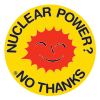Our website is made possible by displaying online advertisements to our visitors.
Please consider supporting us by disabling your ad blocker.
Campaign for Nuclear Disarmament
 The CND symbol, designed by Gerald Holtom in 1958. It has become a nearly universal peace symbol used in many different versions worldwide.[1] | |
| Abbreviation | CND |
|---|---|
| Formation | November 1957 |
| Location | |
Region served | United Kingdom |
General Secretary | Kate Hudson |
Chair | Tom Unterrainer |
Vice-Chair | Sophie Bolt Ellie Kinney Daniel Blaney |
Vice-President | Caroline Lucas Paul Oestreicher Jeremy Corbyn Alice Mahon Rebecca Johnson Ian Fairlie John Cox Pat Arrowsmith[2] |
| Website | cnduk |
| Anti-nuclear movement |
|---|
 |
| By country |
| Lists |
The Campaign for Nuclear Disarmament (CND) is an organisation that advocates unilateral nuclear disarmament by the United Kingdom, international nuclear disarmament and tighter international arms regulation through agreements such as the Nuclear Non-Proliferation Treaty. It opposes military action that may result in the use of nuclear, chemical or biological weapons, and the building of nuclear power stations in the UK.
CND began in November 1957 when a committee was formed, including Canon John Collins as chairman, Bertrand Russell as president and Peggy Duff as organising secretary. The committee organised CND's first public meeting at Methodist Central Hall, Westminster, on 17 February 1958. Since then, CND has periodically been at the forefront of the peace movement in the UK. It claims to be Europe's largest single-issue peace campaign. Between 1958 and 1965 it organised the Aldermaston March, which was held over the Easter weekend from the Atomic Weapons Establishment near Aldermaston to Trafalgar Square, London.
- ^ "World's best-known protest symbol turns 50". BBC News. London: BBC News Magazine. 20 March 2008. Retrieved 25 May 2008.
- ^ "CND's Structure". London: Campaign for Nuclear Disarmament. 2021. Retrieved 16 June 2022.
Previous Page Next Page
حملة نزع السلاح النووي Arabic Campanya per al desarmament nuclear Catalan CND CY Campaign for Nuclear Disarmament German Kampanjo por Nuklea Senarmigado EO Campaña para el Desarme Nuclear Spanish Campaign for Nuclear Disarmament Finnish Campagne pour le désarmement nucléaire French Feachtas um Dhí-Armáil Núicléach GA Iomairt airson Dì-armachadh Niùclasach GD


